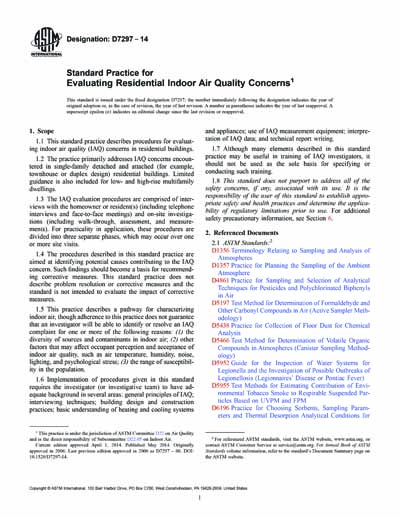Historical
ASTM D7297-14
Standard Practice for Evaluating Residential Indoor Air Quality Concerns
1.1 This standard practice describes procedures for evaluating indoor air quality (IAQ) concerns in residential buildings.
1.2 The practice primarily addresses IAQ concerns encountered in single-family detached and attached (for example, townhouse or duplex design) residential buildings. Limited guidance is also included for low- and high-rise multifamily dwellings.
1.3 The IAQ evaluation procedures are comprised of interviews with the homeowner or resident(s) (including telephone interviews and face-to-face meetings) and on-site investigations (including walk-through, assessment, and measurements). For practicality in application, these procedures are divided into three separate phases, which may occur over one or more site visits.
1.4 The procedures described in this standard practice are aimed at identifying potential causes contributing to the IAQ concern. Such findings should become a basis for recommending corrective measures. This standard practice does not describe problem resolution or corrective measures and the standard is not intended to evaluate the impact of corrective measures.
1.5 This practice describes a pathway for characterizing indoor air, though adherence to this practice does not guarantee that an investigator will be able to identify or resolve an IAQ complaint for one or more of the following reasons: (1) the diversity of sources and contaminants in indoor air; (2) other factors that may affect occupant perception and acceptance of indoor air quality, such as air temperature, humidity, noise, lighting, and psychological stress; (3) the range of susceptibility in the population.
1.6 Implementation of procedures given in this standard requires the investigator (or investigative team) to have adequate background in several areas: general principles of IAQ; interviewing techniques; building design and construction practices; basic understanding of heating and cooling systems and appliances; use of IAQ measurement equipment; interpretation of IAQ data; and technical report writing.
1.7 Although many elements described in this standard practice may be useful in training of IAQ investigators, it should not be used as the sole basis for specifying or conducting such training.
1.8 This standard does not purport to address all of the safety concerns, if any, associated with its use. It is the responsibility of the user of this standard to establish appropriate safety and health practices and determine the applicability of regulatory limitations prior to use. For additional safety precautionary information, see Section 6.
ASTM International [astm]

